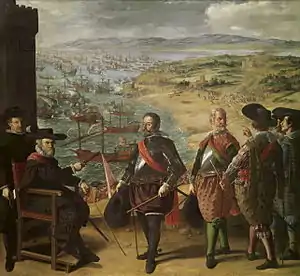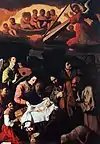Francisco de Zurbarán
Francisco de Zurbarán (/ˌzʊərbəˈrɑːn/ ZOOR-bə-RAHN, Spanish: [fɾanˈθisko ðe θuɾβaˈɾan]; baptized 7 November 1598 – 27 August 1664[3]) was a Spanish painter. He is known primarily for his religious paintings depicting monks, nuns, and martyrs, and for his still-lifes. Zurbarán gained the nickname "Spanish Caravaggio", owing to the forceful use of chiaroscuro in which he excelled.
Francisco de Zurbarán | |
|---|---|
 | |
| Born | baptized 7 November 1598 |
| Died | 27 August 1664 (aged 65) Madrid, Spain |
| Nationality | Spanish |
| Known for | painting |
| Movement | Baroque Caravaggisti |
| Patron(s) | Philip IV of Spain Diego Velázquez |
He was the father of the painter Juan de Zurbarán.[4]
Biography

Zurbarán was born in 1598 in Fuente de Cantos, Extremadura; he was baptized on 7 November of that year.[5][6][7] His parents were Luis de Zurbarán, a haberdasher, and his wife, Isabel Márquez.[6][7] In childhood he set about imitating objects with charcoal.[8] In 1614 his father sent him to Seville to apprentice for three years with Pedro Díaz de Villanueva, an artist of whom very little is known.[9]
Zurbarán's first marriage, in 1617, was to María Paet who was nine years older. María died in 1624 after the birth of their third child. In 1625 he married again to wealthy widow Beatriz de Morales. On 17 January 1626, Zurbarán signed a contract with the prior of the Dominican monastery San Pablo el Real in Seville, agreeing to produce 21 paintings within eight months.[10] Fourteen of the paintings depicted the life of Saint Dominic; the others represented Saint Bonaventura, Saint Thomas Aquinas, and the four Doctors of the Church.[11] This commission established Zurbarán as a painter. On 29 August 1628, Zurbarán was commissioned by the Mercedarians of Seville to produce 22 paintings for the cloister in their monastery.[12] In 1629, the Elders of Seville invited Zurbarán to relocate permanently to the city, as his paintings had gained such high reputation that he would increase the reputation of Seville. He accepted the invitation and moved to Seville with his wife Beatriz de Morales, the three children from his first marriage, a relative called Isabel de Zurbarán and eight servants. In May 1639 his second wife, Beatriz de Morales, died.[13]
Towards 1630 he was appointed painter to Philip IV, and there is a story that on one occasion the sovereign laid his hand on the artist's shoulder, saying "Painter to the king, king of painters".[14] After 1640 his austere, harsh, hard-edged style was unfavorably compared to the sentimental religiosity of Murillo and Zurbarán's reputation declined. Beginning by the late 1630s, Zurbarán's workshop produced many paintings for export to South America.[3] Jacob and his twelve sons, a series depicting the patriarch Jacob and his 12 sons, seems to have been aimed at the South America market, but the originals were acquired for Auckland Castle in Bishop Auckland, Co. Durham, England.[15]
On 7 February 1644, Zurbarán married a third time with another wealthy widow, Leonor de Torder. It was only in 1658, late in Zurbarán's life, that he moved to Madrid in search of work and renewed his contact with Velázquez.[3] Popular myth has Zurbarán dying in poverty, but at his death the value of his estate was about 20,000 reales.[16]
Style

It is unknown whether Zurbarán had the opportunity to see the paintings of Caravaggio, only that his work features a similar use of chiaroscuro and tenebrism (dramatic lighting). The painter thought by some art historians to have had the greatest influence on his characteristically severe compositions was Juan Sánchez Cotán.[17] Polychrome sculpture—which by the time of Zurbarán's apprenticeship had reached a level of sophistication in Seville that surpassed that of the local painters—provided another important stylistic model for the young artist; the work of Juan Martínez Montañés is especially close to Zurbarán's in spirit.[17]
He painted his figures directly from nature, and he made great use of the lay-figure in the study of draperies, in which he was particularly proficient. He had a special gift for white draperies; as a consequence, the houses of the white-robed Carthusians are abundant in his paintings. To these rigid methods, Zurbarán is said to have adhered throughout his career, which was prosperous, wholly confined to Spain, and varied by few incidents beyond those of his daily labour. His subjects were mostly severe and ascetic religious vigils, the spirit chastising the flesh into subjection, the compositions often reduced to a single figure. The style is more reserved and chastened than Caravaggio's, the tone of color often quite bluish. Exceptional effects are attained by the precisely finished foregrounds, massed out largely in light and shade.[14] Backgrounds are often featureless and dark. Zurbaran had difficulty painting deep space; when interior or exterior settings are represented, the effect is suggestive of theater backdrops on a shallow stage.[18]
Zurbaran's late works, such as the Saint Francis (c. 1658–1664; Alte Pinakothek) show the influence of Murillo and Titian in their looser brushwork and softer contrasts.[19]
Artistic legacy

In 1631, he painted the great altarpiece of The Apotheosis of Saint Thomas Aquinas, now in the Museum of Fine Arts of Seville; it was executed for the church of the college of that saint.[20] This is Zurbarán's largest composition,[21] containing figures of Christ, the Madonna, various saints, Charles V with knights, and Archbishop Deza (founder of the college) with monks and servitors, all the principal personages being more than life-size.[14] It had been preceded by numerous pictures for the retable of St. Peter in the cathedral of Seville.[22]
Between 1628 and 1634, he painted four scenes from the life of St. Peter Nolasco for the Principal Monastery of the Calced Mercedarians in Seville.[23] In Santa Maria de Guadalupe he painted multiple large pictures, eight of which relate to the history of St. Jerome;[3] and in the church of Saint Paul, Seville, a figure of the Crucified Saviour, in grisaille, creating an illusion of marble. In 1639, he completed the paintings of the high altar of the Carthusians in Jerez.[24] Also in the 1630s he was commissioned to provide canvases representing the Labours of Hercules, the only group of mythological subjects from the hand of Zurbarán, which were installed in the Hall of Realms in Madrid.[25] A fine example of his work is in the National Gallery, London: a whole-length, life-sized figure of a kneeling Saint Francis holding a skull.[26]
In 1835, paintings by Zurbarán were confiscated from monasteries and displayed in the new Museum of Cádiz.
His principal pupils were Bernabé de Ayala, Juan Caro de Tavira, and the Polanco brothers; others included Ignacio de Ries.
Zurbarán was the subject of a major exhibition in 1987 at the Metropolitan Museum of Art in New York, which traveled in 1988 to Galeries nationales du Grand Palais in Paris.[27] In 2015, the Thyssen-Bornemisza Museum in Madrid presented Zurbarán. A New Perspective.[28]
Selected works
- Christ on the Cross (1627), Art Institute of Chicago
- Hercules and the Hydra
- St Hugh in the Carthusian Refectory (1630–1635), Museum of Fine Arts of Seville
- Still Life with Pots (1650), Museo del Prado (autographed version)
Gallery

 Saint Serapion, 1628, Wadsworth Atheneum
Saint Serapion, 1628, Wadsworth Atheneum Visión de San Pedro Nolasco, 1629, Museo del Prado
Visión de San Pedro Nolasco, 1629, Museo del Prado.jpg.webp) Immaculate Conception, 1630, Museo del Prado
Immaculate Conception, 1630, Museo del Prado The Death of St. Bonaventure (The Body of St. Bonaventure in the Presence of Pope Gregory X and James I of Aragon), 1629–1630, Louvre Museum
The Death of St. Bonaventure (The Body of St. Bonaventure in the Presence of Pope Gregory X and James I of Aragon), 1629–1630, Louvre Museum The Young Virgin, 1630, Metropolitan Museum of Art
The Young Virgin, 1630, Metropolitan Museum of Art
 The Defence of Cádiz against the English, 1634, Museo del Prado
The Defence of Cádiz against the English, 1634, Museo del Prado A Doctor of Law, 1635, Isabella Stewart Gardner Museum
A Doctor of Law, 1635, Isabella Stewart Gardner Museum Santa Isabel de Portugal, c. 1635, Museo del Prado
Santa Isabel de Portugal, c. 1635, Museo del Prado Saint Luke as a Painter before Christ on the Cross, c. 1635–1640, Museo del Prado
Saint Luke as a Painter before Christ on the Cross, c. 1635–1640, Museo del Prado The Annunciation, 1637–1639, Museum of Grenoble, France
The Annunciation, 1637–1639, Museum of Grenoble, France Saint Rufina, c. 1635–1640, National Gallery of Ireland
Saint Rufina, c. 1635–1640, National Gallery of Ireland The Adoration of the Shepherds, 1638, Museum of Grenoble
The Adoration of the Shepherds, 1638, Museum of Grenoble Saint Francis of Assisi in His Tomb, 1630/34, Milwaukee Art Museum
Saint Francis of Assisi in His Tomb, 1630/34, Milwaukee Art Museum Saint Francis in Meditation, 1639, National Gallery
Saint Francis in Meditation, 1639, National Gallery
 The Holy Family, 1659, Szépmûvészeti Múzeum
The Holy Family, 1659, Szépmûvészeti Múzeum Christ, recovering clothing after flagellation c. 1661, Jadraque, Spain
Christ, recovering clothing after flagellation c. 1661, Jadraque, Spain Christ at the Column, 1661, National Museum, Wrocław
Christ at the Column, 1661, National Museum, Wrocław Saint Francis, c. 1658–1664, Alte Pinakothek
Saint Francis, c. 1658–1664, Alte Pinakothek The Martyrdom of Saint Sebastian, MNHA Luxembourg
The Martyrdom of Saint Sebastian, MNHA Luxembourg Agnus Dei, c. 1635–1640, Museo del Prado
Agnus Dei, c. 1635–1640, Museo del Prado
References
Citations
- Bussagli & Reiche 2009, p. 95.
- Pérez 2004, p. 147.
- Ressort & Jordan 2003.
- "Two new paintings now on display". National Gallery. 2018. Retrieved 18 March 2021.
- Harris 2005, p. 208.
- Gállego & Gudiol 1977, p. 135.
- Baticle 1987, p. 53.
- Rossetti 1911, p. 1056.
- Gállego & Gudiol 1987, p. 13.
- Gállego & Gudiol 1987, p. 16.
- Gállego & Gudiol 1987, p. 73.
- Gállego & Gudiol 1987, p. 127.
- Gállego & Gudiol 1987, p. 18.
- Rossetti 1911, p. 1057.
- "Zurbarán paintings : Art and exhibitions at Auckland Castle". The Auckland Project. Retrieved 20 January 2020.
- Goodwin 2015, p. 474.
- Gállego & Gudiol 1987, p. 15.
- Gállego & Gudiol 1987, pp. 60–61.
- Gállego & Gudiol 1987, pp. 20, 67.
- Gállego & Gudiol 1987, p. 82.
- Mallory 1990, p. 116.
- Gállego & Gudiol 1987, pp. 79–80.
- Gállego & Gudiol 1987, p. 74.
- Gállego & Gudiol 1987, p. 86.
- "Hercules as a Symbol of the Spanish Monarchy". Splendor, Myth, and Vision: Nudes from the Prado. Retrieved 20 January 2020.
- MacKenzie (2018). "Write on Art:"Saint Francis"". Art UK.
- Gilbert 1987.
- "Exposición – Zurbarán. A New Perspective". Museo Nacional Thyssen-Bornemisza. Retrieved 20 January 2020.
- "Santo Domingo in Soriano". artehistoria.com (in Spanish). 2017. Retrieved 20 January 2020.
Sources
- Baticle, Jeannine (1987). "Francisco de Zurbaran: A Chronological Review". In Baticle, Jeannine (ed.). Zurbaran. Metropolitan Museum of Art.
- Bussagli, Marco; Reiche, Mattia (2009). Baroque & Rococo. New York and London: Sterling. ISBN 978-1-4027-5925-3.
- Gállego, Julián; Gudiol, José (1977). Zurbarán, 1598-1664. Secker & Warburg. ISBN 9780436172205.
- Gállego, Julián; Gudiol, José (1987). Zurbará. London: Alpine Fine Arts Collection, Ltd. ISBN 0-88168-115-6.
- Gilbert, Creighton (December 1987). "Zurbarán, for the most part". The New Criterion.
- Goodwin, Robert (2015). Spain: The Centre of the World 1519–1682. Bloomsbury. ISBN 978-1-4088-4357-4.
- Harris, Ann Sutherland (2005). Seventeenth-century Art and Architecture. Laurence King. ISBN 978-1-85669-415-5.
- Mallory, Nina A. (1990). El Greco to Murillo: Spanish Painting in the Golden Age, 1556-1700. Harper & Row. ISBN 978-0-06-435531-5.
- Pérez, Javier Portús (2004). The Spanish Portrait: From El Greco to Picasso. Museo Nacional del Prado. ISBN 978-1-85759-374-7.
- Ressort, Claudie; Jordan, William B. (2003), "Zurbarán, de family", Grove Art Online, doi:10.1093/gao/9781884446054.article.T093699, ISBN 9781884446054
- This article incorporates text from a publication now in the public domain: Rossetti, William Michael (1911). "Zurbaran, Francisco". In Chisholm, Hugh (ed.). Encyclopædia Britannica. Vol. 28 (11th ed.). Cambridge University Press. pp. 1056–1057.
External links
- Zurbarán, an exhibition catalog from The Metropolitan Museum of Art (fully available online as PDF)

